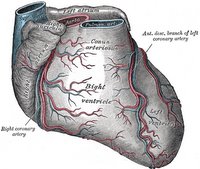 A 56-year-old male with coronary artery disease (CAD) presented with angina, nonspecific electrocardiographic (ECG) changes, and elevated troponins.
A 56-year-old male with coronary artery disease (CAD) presented with angina, nonspecific electrocardiographic (ECG) changes, and elevated troponins.Coronary angiography revealed total occlusion of a stent in the circumflex artery, where another was deployed—his 67th stent.
The patient had 28 catheterizations over 10 years, with stents placed in his native coronary arteries as well as in 3 bypass grafts. All stents were placed to relieve his angina, refractory to maximal medical treatment and transmyocardial laser revascularization.
Stents can be a great tool to help revascularization and relieve symptoms; unfortunately, they are prone to thrombosis and restenosis. If they fail while medical management is maximized unsuccessfully, alternative tools are lacking.
This case raises many questions, among them: "How much is too much?"
Clearly, this is not an example of standard of care. Should we be concerned that this case is indicative of a system that has lost its way?
References:
This case raises many questions, among them: "How much is too much?"
Clearly, this is not an example of standard of care. Should we be concerned that this case is indicative of a system that has lost its way?
References:
A Heart With 67 Stents. J Am Coll Cardiol, 2010; 56:1605, doi:10.1016/j.jacc.2010.02.077
67 stents, 28 coronary angiograms, and a crippled healthcare system. Eric Topol, 2010.
Image source: Gray's Anatomy, 1918, public domain.
Comments from Facebook and Twitter:
Talk about a full metal jacket! Baby!
One thing's for sure, no surgeon is going to touch him now for bypass. I did note, however, that he still does not have an LV lead for biV pacing, so he might not be done with procedures yet! :)
Surgeons are smart these days, they separate stent struts and graft! There is definite scope for a Combo device .
This case is indicative of system , that is addicted to invasive interventoin I suppose...Nevertheless it's quite interesting.
Not to mention the radiation.
No comments:
Post a Comment
Note: Only a member of this blog may post a comment.